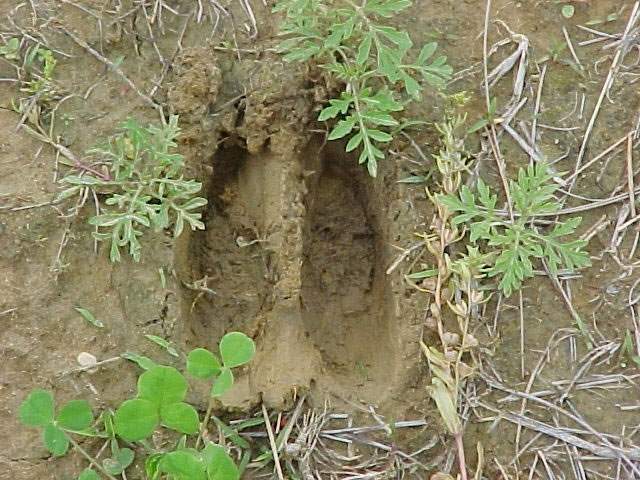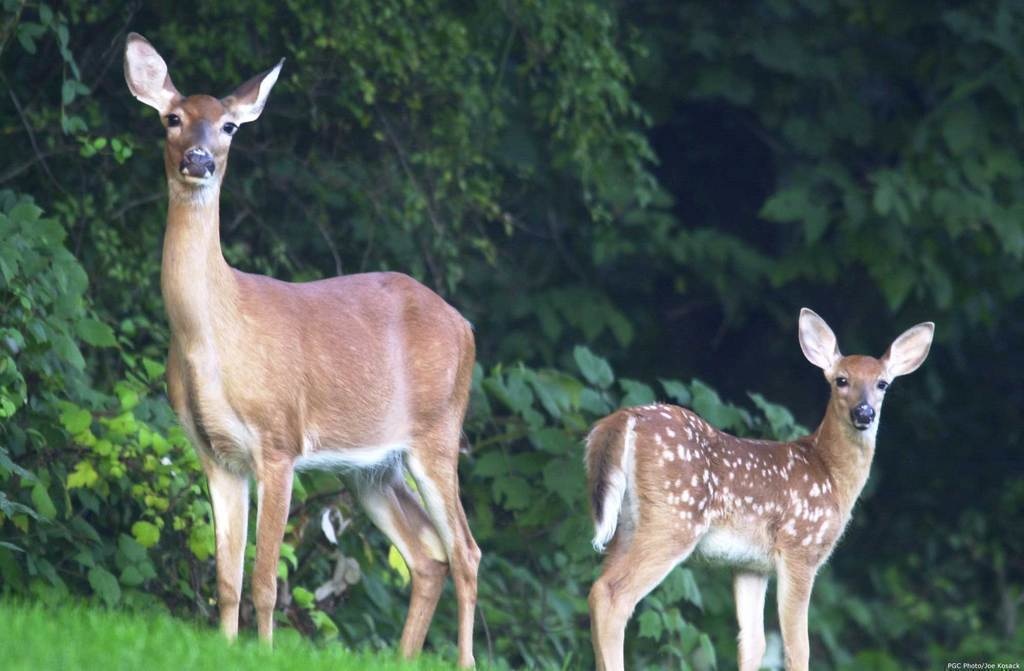Check in weekly, on Wednesdays, to read our new post on gardening, harvesting, and making use of that fine, extra-local produce! We’ll share tips and techniques, gleaned from our urban farms and gardens. Email info@growpittsburgh.org with any topics you’d like us to cover.
Deer can be more than a nuisance in the garden – they can totally destroy it! In this article, we’ll offer some tips and techniques for protecting your garden plants from the devastating munching of deer.
Deer populations vary across the region. Interestingly, developed regions often have higher populations of deer than thick woodland. Since deer browse on grasses, herbaceous plants, and brush, they thrive at the edges of deciduous forests, and in brushy areas that are in the early stages of succession into woodland. These forest edges are common in residential areas.

A whitetail deer footprint. The rounded area is the back of the deer’s hoof, while the pointy area is the front. Photo from Illinois DNR.
Most often, you’ll know if you’ve got deer frequenting the garden. If you haven’t seen them, you’ve probably seen their hoof prints, droppings, and browsing damage on plants. If you aren’t sure whether deer are the culprit, keep an eye out for the signs listed above, and quietly observe the garden in the evening, when deer are most active. Damage on plants is usually significant. Groundhog and rabbit damage can look similar, but deer can reach higher on plants and remove more plant material in one feeding.
Deer eat most plants in the vegetable garden, with the exception of crops in the onion family (like garlic, leeks, and chives). They also usually avoid hot peppers. Deer eat a large variety of ornamental plants, flowers, and bushes– sometimes even those considered to be deer-resistant. Check online lists for deer-resistant plants but also ask other gardeners in the neighborhood what varieties have worked for them.
The best way to protect a garden from deer is to place it in an area that is inaccessible to the deer. This can be easier said than done! To keep deer out, fencing must be at least 8’ tall. Alternatively, two strands of electric fence, both 3’ high and 3’ apart, can be used with some success, as deer are wary of jumping across a double fence. Electric fence can be powered by a solar charger, if there is no electricity at the garden site. If deer fencing is not an option in an area with significant deer population, reconsidering the location of the garden may be the best plan. Could the garden be grown in large containers on a deck? Alternatively, if you’re growing short crops, covering them with fabric row cover as a barrier can be effective.

A mother whitetail deer (doe) and fawn. Photo from PA Game Commission.
If deer fencing is not an option and deer pressure is light to moderate, repellants can be a viable option. Repellants made of various substances like mint, garlic and hot pepper, putrefied egg, and blood meal are commercially available. Some gardeners make their own repellants from similar substances or from human hair, urine, or soap. These types of repellants can be effective, especially if they are applied around the perimeter of the garden, like a fence. They need to be reapplied after each rain, so they can be labor intensive.
Another option is to scare away deer with active repellants. For instance, a dog allowed to roam at will in a yard can be an effective tool against deer. A commercially available tool called the Scarecrow can be attached to a hose and emits a rapid burst of water when it senses movement. Ultrasonic devices are also available, but don’t seem to work consistently. Also, sometimes their emitted sound can be heard by human ears, which can be annoying to residents and neighbors.
So, here’s a recap of options for keeping deer out of your garden!
- Plant resistant crops
- 8’ or taller fence
- Double electric fence, 3’ tall, 3’between fencing
- Reconsider garden location – could it be worth moving to a less deer-heavy area or planting a container garden?
- Fabric row cover
- Commercially-made repellants
- Homemade repellants
- Dog with constant access to garden area
- The “Scarecrow”
- Ultrasonic devices
